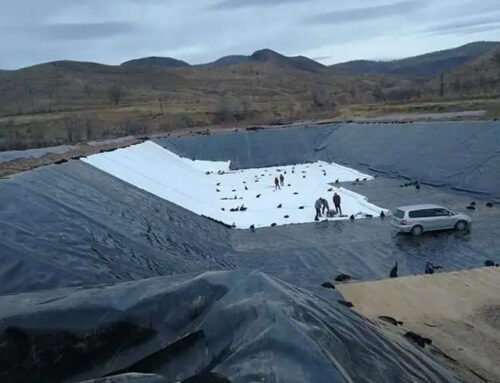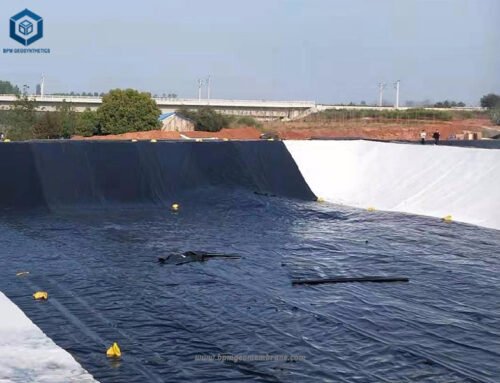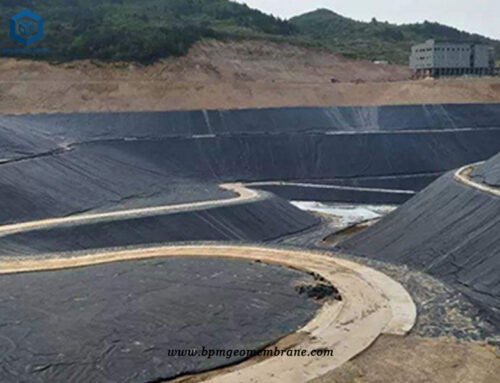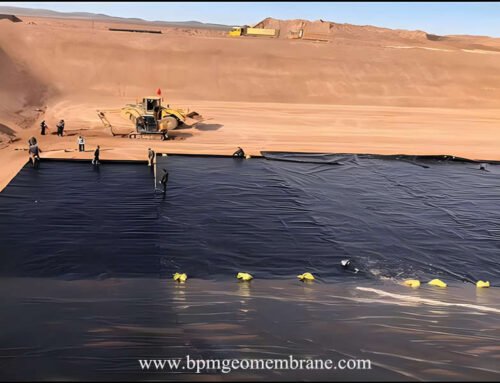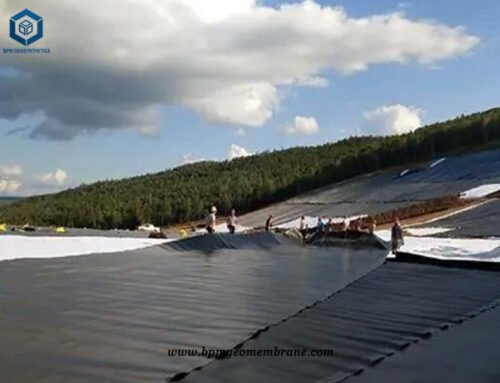Geomembrane liner HDPE, also known as geomembrane HDPE liner, has been used significantly in the mining industry since about 1970 for lining solution of evaporation ponds, tailings impoundments and heap leach pads. The most extensive use of the HDPE geomembrane liner has been, and remains, in the construction of evaporation ponds, starting in the early 1970’s, and heap leach pads starting in the late 1970’s. Tailings impoundments have historically been mostly soil lined, but increasing in their use of plastic geomembrane in recent times.
BPM Geomembrane is the leading HDPE geomembrane manufacturer and supplier, we whole sale geoemmbrane liner HDPE at best factory price.
1. What Is Geomembrane Liner HDPE?
Geomembrane liner HDPE, also known as High-Density Polyethylene, is a versatile material widely used in containment applications. It offers a range of benefits, including its low cost, excellent chemical resistance, and exceptional weathering properties.
HDPE is specifically used for manufacturing heavy-duty liners and geomembranes, making it suitable for demanding applications. These liners are available in various thicknesses, typically ranging from 20 mils up to 120 mils, making HDPE one of the thickest liner options available.
Smooth liner HDPE is produced in thicknesses of 0.5, 0.75, 1.0, 1.5, 2.0, 2.5, and 3.0mm (20, 30, 40, 60, 80, 100, 120 mils). The rolls typically have a width of 23 feet and vary in length depending on the thickness of the geomembrane liner.
One of the key advantages of HDPE liner is its resistance to UV radiation and chemicals, ensuring long-lasting performance and durability even when exposed to harsh environmental conditions. It is known for its excellent chemical resistance, making it suitable for various applications.
Geomembrane liner HDPE is a cost-effective and versatile material widely used in containment applications. Its excellent chemical resistance, durability, and puncture resistance make it a preferred choice for various industries, including mining. Whether it’s for environmental protection, waste management, or resource recovery, HDPE liners provide reliable and long-lasting containment solutions.


2. How To Make Geomembrane Liner HDPE?
To manufacture smooth geomembrane liner HDPE, the following steps are typically involved:
2.1 Raw Material Selection
High-quality polyethylene resin is chosen as the primary raw material for the geomembrane liner. This resin should have the necessary properties, such as high molecular weight and good flexibility.
2.2 Additives
Various additives are incorporated into the HDPE resin to enhance its performance. These additives may include carbon black, which provides UV resistance and prevents degradation caused by exposure to sunlight. Antioxidants and anti-aging agents are also added to improve the liner’s durability and longevity.
2.3 Production Equipment
State-of-the-art automatic production equipment is used to manufacture the HDPE geomembrane liner. This equipment ensures precision and consistency in the production process.
2.4 Three-Layer Pressing Technology
The HDPE geomembrane liner is created using a three-layer pressing technology. This involves layering multiple sheets of HDPE resin with the additives in between. The layers are then pressed together under controlled heat and pressure to create a uniform and strong geomembrane liner.
2.5 Types of HDPE Geomembrane Liner
HDPE geomembrane liners can be categorized into three main types: low-density polyethylene (LDPE) geomembrane, high-density polyethylene (HDPE) geomembrane, and linear low-density polyethylene (LLDPE) geomembrane. The selection of the appropriate type depends on the specific requirements of the application.
2.6 Compliance with Standards
It is crucial to ensure that the HDPE geomembrane liner meets industry standards. These standards may include GB (Chinese National Standards), GRI (Geosynthetic Research Institute), and ASTM (American Society for Testing and Materials) standards. Compliance with these standards ensures the quality and performance of the geomembrane liner.
By following these steps and using high-quality materials and advanced production techniques, manufacturers can produce smooth geomembrane liner HDPE that meets the necessary standards and provides reliable waterproofing and containment properties.
3. What Are The Benifits of Geomembrane Liner HDPE?
Geomembrane liner HDPE offers several benefits that make it a preferred choice for various applications. Here are the key advantages of using HDPE geomembrane liner:
-
Excellent Chemical Resistance
HDPE liner exhibits exceptional resistance to corrosion caused by a wide range of chemicals. This property ensures reliable containment and protection against chemical leaks or spills, making it suitable for applications in industries such as mining, agriculture, and waste management.
-
Resistance to Stress Cracking
HDPE geomembrane liner has excellent resistance to stress cracking, which refers to the development of cracks under environmental stress. This characteristic ensures the liner’s durability and longevity, even in challenging conditions where stress is applied, such as high-pressure environments or fluctuating temperatures.
-
Lowest Permeability
HDPE liner has the lowest permeability among geosynthetic liners, meaning it provides an effective barrier against the seepage or leakage of liquids and gases. This property is crucial for containment applications, such as lining landfills, ponds, or reservoirs, where preventing the migration of contaminants is essential.
-
Excellent UV Resistance
HDPE geomembrane liner has outstanding resistance to ultraviolet (UV) radiation from the sun. This UV resistance prevents the liner from degrading or deteriorating when exposed to sunlight, ensuring its long-term performance and stability, even in outdoor applications.
-
Stable Low-Temperature Embrittlement Resistance
HDPE liner maintains its flexibility and integrity even at low temperatures. It resists embrittlement, which is the tendency to become brittle in cold environments. This property allows HDPE liner to withstand freezing temperatures without sacrificing its performance or structural integrity.
-
Complete Width and Thickness Specifications
HDPE geomembrane liner is available in a wide range of widths and thicknesses, allowing for customization based on specific project requirements. This flexibility ensures that the liner can be tailored to meet the needs of different applications, providing a reliable and efficient solution.
-
Low Cost and Simple Construction
HDPE liner offers a cost-effective solution for containment projects. Its relatively low cost, combined with its ease of installation, makes it an attractive choice for various industries. The simple construction process reduces labor and time requirements, resulting in overall cost savings.
The benefits of HDPE geomembrane liner include excellent chemical resistance, resistance to stress cracking, lowest permeability, excellent UV resistance, stable low-temperature embrittlement resistance, complete width and thickness specifications, and cost-effectiveness. These advantages make HDPE liner a reliable and efficient choice for a wide range of containment applications.
4. Case of Geomembrane Liner HDPE for Copper Mining Processing Pond in Congo
BPM is collaborating with a prominent gold mining company in Congo, known for its abundant gold mines. The client holds multiple licenses issued by the Congo government for various aspects of their operations. They approached BPM in May to obtain certification for the chemical and UV resistance of geomembrane liners.
BPM’s expertise in providing geomembrane liners with excellent chemical and UV resistance makes them an ideal choice for the client’s requirements. The sought-after certificates ensure that the liners can withstand the corrosive nature of mining chemicals and intense UV radiation prevalent in Congo. By using these certified geomembrane liners, the mining company can effectively protect the environment, prevent leakage, and safeguard nearby soil and water sources.


BPM obtained a chemical and UV certificate for their HDPE geomembrane pond liner to address environmental and groundwater contamination risks in gold and copper mining. Rigorous testing by a national chemical testing center resulted in an authorized certificate. The 2.0mm HDPE liner serves as a waterproof base with additional components for a comprehensive drainage system.
BPM certified geomembrane liner HDPE and comprehensive drainage system can effectively mitigate the risk of contamination, protect the environment, and ensure the safety of underground water sources during their gold mining operations.
5. Specification of Geomembrane Liner HDPE for Copper Mining Processing Pond in Congo
- Total HDPE geomembrane quantity – 200000 square meters
- Each roll size – 7m*100m
- Smooth geomembrane thickness – 2.0mm and 0.5mm.
6. About BPM
BPM Geomembrane has been specializing in delivering one stop geosynthetics products and solutions to worldwide customers since its foundation in 2007. BPM had provided many types of effective and state of the art geomembranes, geotextiles, geocells, geosynthetic clay liners (GCLs), drainage boards, geogrids to over 81 countries. BPM is not only manufacturing best quality geosynthetic products but also providing professional design and installation service. OEM, ODM, custom development and fabrication are also available. If you have any questions or inquiries, please contact us, we will reply as soon as possible.

